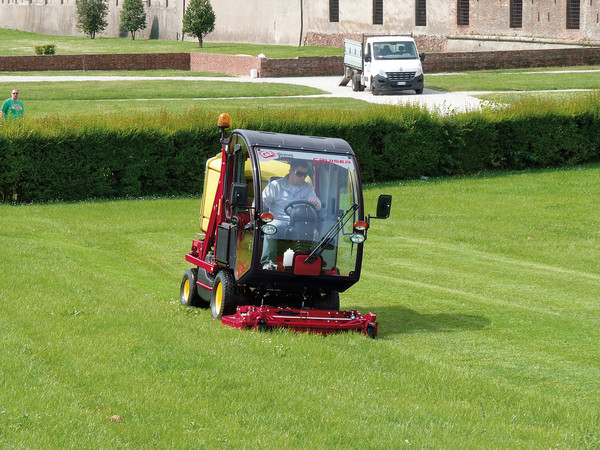
Mowers with driver on board, an innovative segment
This type of machines, mainly used for professional maintenance, has a wide range of solutions both for the engines and for the cutting decks. From the petrol engine to the electric and hybrid motor, from the front cutting deck to the ventral or lateral one, the industry offers the most suitable means for the most different applications
The category of the mowers with driver on board has had a strong development. First of all, in the motorization, that is to say, engines powered by: petrol, Diesel, gas, electric battery; in addition to the hybrid engine (endothermic and electric). The comparatively life cycle analysis (LCA), carried out by the French Véritas Studio, on three types of motorization, petrol, gas, and electric, based on a 1000-hour use in three years for a total of 6500 km traveled, has supplied the following carbon footprints expressed in kg of CO2 / km: petrol 1.45; gas 0.83; electric 0,40. It is therefore clear the lower environmental impact of the electric motor compared to the other two types of engines. The electric engine, however, is still limited to low powers, while the hybrid solution is being applied for golf courses. These mowers are divided into three categories according to the position of the engine and of the cutting deck: 1) the category with the engine placed in front of the driver and the cutting deck in the ventral position, 2) the one with the engine behind the driver and the cutting deck in the ventral position, 3) and the one with the engine behind the driver and the cutting deck in frontal, ventral and lateral position.
In models with cutting deck in the ventral position, the type is that of rotating blades on a vertical axis. The cut grass can be collected in the rear basket or unloaded sideways. Another solution is mulching The cutting deck placed in front can be: with rotating blades on a vertical axis; with helical blades; with rotating blades on a horizontal axis.
Engine placed in front of the driver (Lawn tractor)
Originally they came from small-powered agricultural tractors implemented with the cutting deck in the ventral position and garden tires. The transmission can be mechanical, for models with a working width of less than one meter, or hydrostatic. In the rear axle, there are the driving wheels, in the front one the steering wheels. The working width stands between 0.60-0.70 m and 1.30 m and even more; as a result, the engine power ranges from 6-8 kW to 20-25 kW. Depending on the working width, the cut is made by one, two or three rotating blades; the most frequent solution is the two asynchronous blades one. The frontal position of the engine reduces the driver’s visibility with a possible impact on the accuracy of the work. In most cases, the maneuverability of the machine is not very large and this is a disadvantage when operating on irregularly shaped turfs or when there are trees, shrubs, and flowerbeds. However, models with reduced turning radius are also allowed, since the internal rear wheel goes into neutral at the moment of steering. In general terms, it can be said that this category is not the most suitable for high-quality turfs.
Rear engine and ventral cutting equipment (Rider)
To improve the quality of the work, other models of lawnmowers were built with the engine placed behind the ventrally positioned cutting deck. The machine is compact and the operator has complete visibility. On the market, two types are available: one with rear driving wheels and directors, which allow having zero turning radius, and another one with front steering wheels. The first type offers great maneuverability. A drive wheel can be locked and rotated towards the rear while the other rotates forward. The transmission system is generally hydraulic and the maneuverability of the machine is not made with the steering wheel but is controlled by directional and motorized levers. The width of the cutting deck stands between 0.80-1.80 m and the engine power ranges from 10-12 kW to 25-30 kW. The engagement of the blades is generally mechanical. This type of mower is particularly suitable for use on quality lawns, even with irregular shapes and obstacles. The enhanced maneuverability allows avoiding or minimizing, the cutting finishing operations while operating in difficult conditions. The second type, with front wheels forward, does not allow to make such precise and accurate cuts as those of the previous type. The working widths are in the range of 0.80 m and 1.50 m, therefore the engine power varies between 8-10 kW to 20-25 kW. The transmission can be mechanical or hydraulic, while the engagement of the blades is mechanical.
Rear engine and frontal, ventral or lateral cutting deck
In this category, the two front wheels are driven and the two rear wheels are generally direct; in some models, they can be also driven. It is a category of machines with different versions, as it can have the cutting deck in frontal, ventral and also lateral position. The chassis of the machine, the engine, the transmission, the wheels and the same braking system, are linked to the type and width of job that can vary from 1.20 m to 5.00 m. The cutting decks can be hydraulically raised more or less completely and this simplifies maintaining and cleaning. All models allow the operator to see the entire surface of the turf thus allowing the job to be carried out precisely. There are three basic types. A front deck. The working width goes from 1.20 m to 3.00 m with engine power from 12 kW to 45 kW. For widths up to 2 m, there is only one deck, while for larger sizes there is a central deck and two more lateral ones that can be lifted. This allows to chose the working width according to the operating conditions. Three independent decks. In this type the working width reaches 5.00 m. The decks, autonomously operated, are found in a frontal, lateral and ventral position. It is possible to operate using all three positions of the decks or by putting into operation a single deck (front for example), or even two decks (front and side for example). The engine power reaches 70-75 kW.
Floating multidecks.They have been recently introduced on the market in order to allow a good quality of work on turfs with a variable or uneven lie of the terrain. The cutting decks have a 0,60 m width and, being floating, follow the contour of the ground allowing to maintain the same cutting height irrespective of the irregularity of the terrain The most common version is the three-decks version (two fronts and one side) with an engine power of 25-30 kW.
Hybrid mower
The hybrid motorization has been recently introduced and essentially concerns the mowers specific for golf with a cutting deck with cylinder blades. The triple version for greens, with a working width of 1.57 m with a power output of 14.5 kW, was equipped with an alternator that allows the engine to run at reduced speed, maintaining a constant power for a quality optimal cut from one green to another. Fuel consumption, with this solution, is reduced by 50% compared to the traditional model. This means a 3 liters of fuel save in cutting 18 greens. Considering that in summer the cut is daily, this saving is not insignificant. The same solution has been chosen for a quintuple by Fairways with a working width of 2.54 m and an engine power of 27.5 kW.








